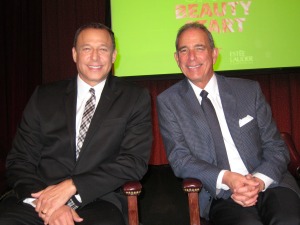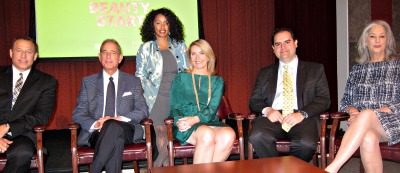
2014-05-14 22:09:45
Fashion Group International Explores Beauty Brand Strategies
2014-05-14 22:09:45
By Nancy Jeffries
|
|
The Fashion Group International (FGI) celebrated The Art of the Beauty Start, April 30, 2014, with a panel of beauty industry innovators.
Caroline Fabrigas, president, Scent Marketing Institute, and FGI board member, introduced the experts who meet the challenges of today’s multi-faceted and changing marketplace, noting that the pioneering spirit of beauty is not gone.
The panel of experts included Karen Grant, vice president and beauty analyst, The NPD Group— and a member of Beauty Packaging’s Board of Advisors; Peter Lichtenthal,president, Bumble and bumble; Howard Kreitzman, vice president Cosmetics & Fragrances,Bloomingdale’s; Claudia Lucas, merchandise director for beauty, QVC; Paulo Lima, co-founder, IT Cosmetics; and Essie Weingarten, founder and global creative director, essie.
Mary Murcko, VP and publisher, Self Magazine, said each lent a different perspective to engage, shape, invent, and re-invent new products for today’s beauty consumer; while Grant marveled that the combined wisdom of the panelists exceeded 100 years.
Invent and Re-Invent
The keys to successful invention of a brand must include authenticity. Claudia Lucas, QVC, said, “From our perspective it’s about storytelling and authenticity. If there’s a reason why this brand exists, it’s because its passion is a point of distinction.” Lucas, a senior retail merchandising executive with 20 years of experience in the UK and USA, specializing in luxury beauty, emphasized the importance of having a product that really works with its story.
Paulo Lima, IT Cosmetics, which has grown to be one of the largest private color cosmetics companies in the United States, says his company is based on a problem solving paradigm. “We have a brand DNA and we stick to it,” he said. In addition, Lima said partnering with someone that understands who you are, and who can provide a platform for your brand’s story is essential. “With QVC, we have a retail partner that allows us to be true to ourselves.”
Essie Weingarten was emphatic, “Be true to your brand, don’t look at what your competition is doing. We were in the professional nail color business and originally came up with 12 colors that had a personality and a name. People were drawn to our products. It was basically the cheapest addiction around,” said Weingarten, whose company was recently acquired by L’Oréal. “You’re looking at the American dream,” she said.
Howard Kreitzman, Bloomingdale’s looked at origins as well, saying, “We came out of no place and evolved into a place where women like to shop. We bring people in for our brand values.”
|
|
Peter Lichtenthal, Bumble & bumble, and Smashbox, balances the dual identities of a salon brand and a studio brand, respectively. Bumble and bumble, founded in 1977, and Smashbox, which started in 1996, have retained their original concept images. “What is critical is that you always keep your storytelling fresh, so you are perceived as always having the air of a start-up. Keep true to the storytelling and innovation as you evolve,” said Lichtenthal.
Cultural Identity
When a smaller brand is acquired by a larger entity the fostering of cultural identity is key. Lichtenthal emphasized balance. “Being part of a larger company presents a challenge, as well as considerable benefit in terms of quality and assurance, but we have to have what Grant termed, ‘a split personality,’ ” said Lichtenthal, acknowledging Lauder’s acquisition of the two brands.
“It’s a completely different environment and now we’re a little piece of a puzzle. It’s an amazing fit. It works,” said Weingarten. She acknowledged that her one wish was to have every woman in the world love Essie. “With a big machine behind the brand, it will be able to touch every woman in the world. In 33 years, the brand hasn’t really changed that much. I’m like the guardian angel that looks over it and we hope it will live forever,” said Weingarten.
Clearly, self-fulfilling prophecies are not in everyone’s playbook, and strategies must work to keep the wheels in motion. “There has to be a willingness to work in partnerships,” said Lucas, and there must be readiness for customer acceptance, particularly when a brand takes off. “If a brand sells out on QVC and it takes off, you’d better be ready, because it’s a big machine to build,” added Lucas.
Evolving Times
While the rules are not hard and fast, there is a trend toward a curated model of product offerings in retail. Kreitzman cited the Space NK shops, a successful boutique retail model in Bloomingdale’s, and the vision of founder, Nicky Kinnaird to provide an array of high quality beauty brand offerings under one roof.
Likewise, abundant consumer options in today’s market have also created the need for more excitement surrounding products, and the need for product relevance. While Weingarten’s “Aha” moment came when she received a letter from Her Majesty’s hair dresser requesting “Ballet Slippers”nail color for the Queen, she knows that today’s world is changing, notwithstanding the “honor of being on the best fingertips in the world.”
She acknowledges that e-commerce has been key for the brand, and going with her sense of what was right for the time has been good for her. “In the 80’s, I did pastels, then decided to go dark and dangerous with ‘Wicked,’ first killing it in the UK, and later a success in the US. You’re probably looking at one of the luckiest women in the world because I followed my dream,” said Weingarten.
Making the products relevant and accessible remained key to each brand, with the consensus being that whether online, at kiosks, via social media, or at brick and mortar retail, keeping brands interesting and fresh, being open to consumer choices, and, according to Lichtenthal, “being open to the next generation of experts,” will keep brands relevant. “As you become bigger and the market changes, the old paradigms just don’t always work,” he added.
Lucas was philosophical, “I don’t think it’s just youth. It’s a marriage of the older/wiser wisdom and the younger, fresher outlook. It’s okay to not know everything, but I know I’ve got a team that really understands it, so to have a great team, to trust them as well as the organization is important.”
Kreitzman concurred, “We may get the best ideas coming from a young person in college than the ‘old guys,’ but keeping the connection is essential.”
LinkedIn






